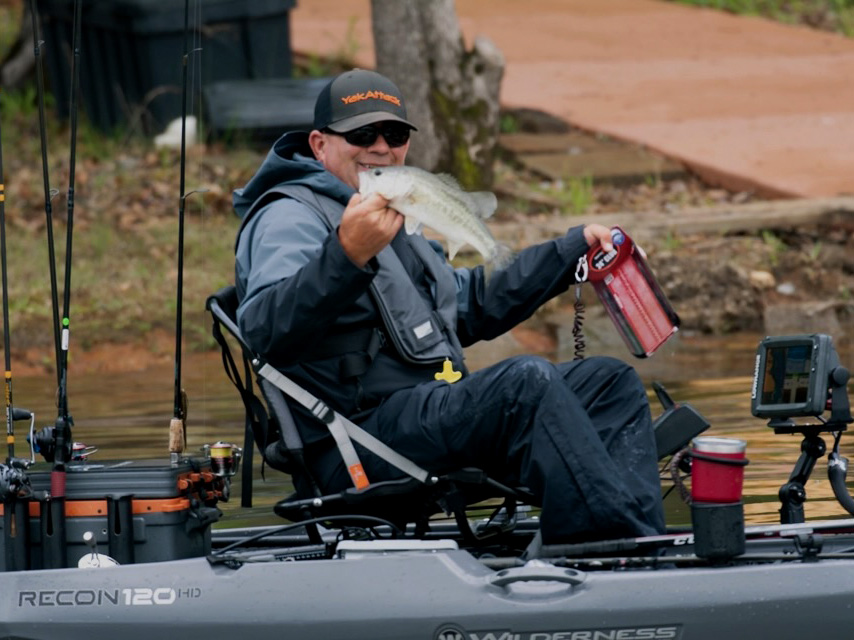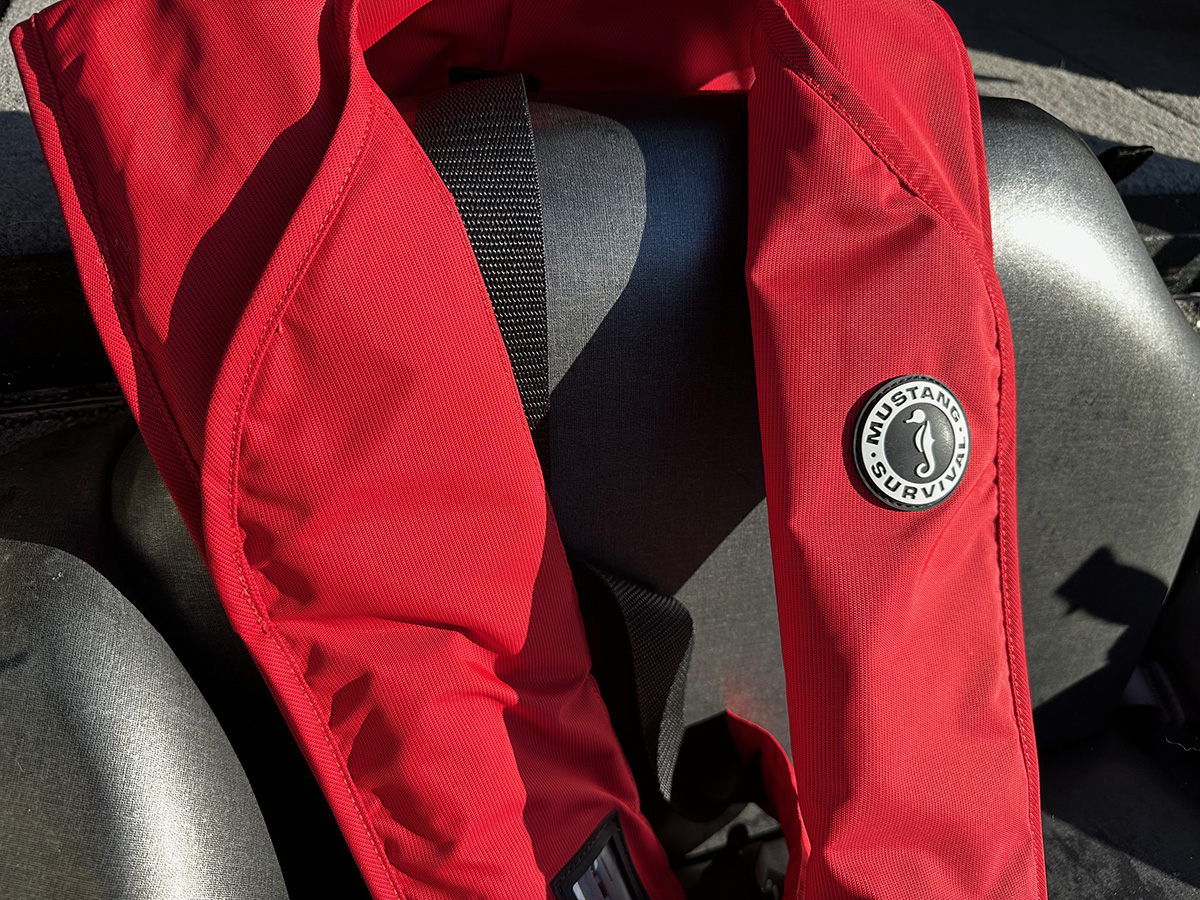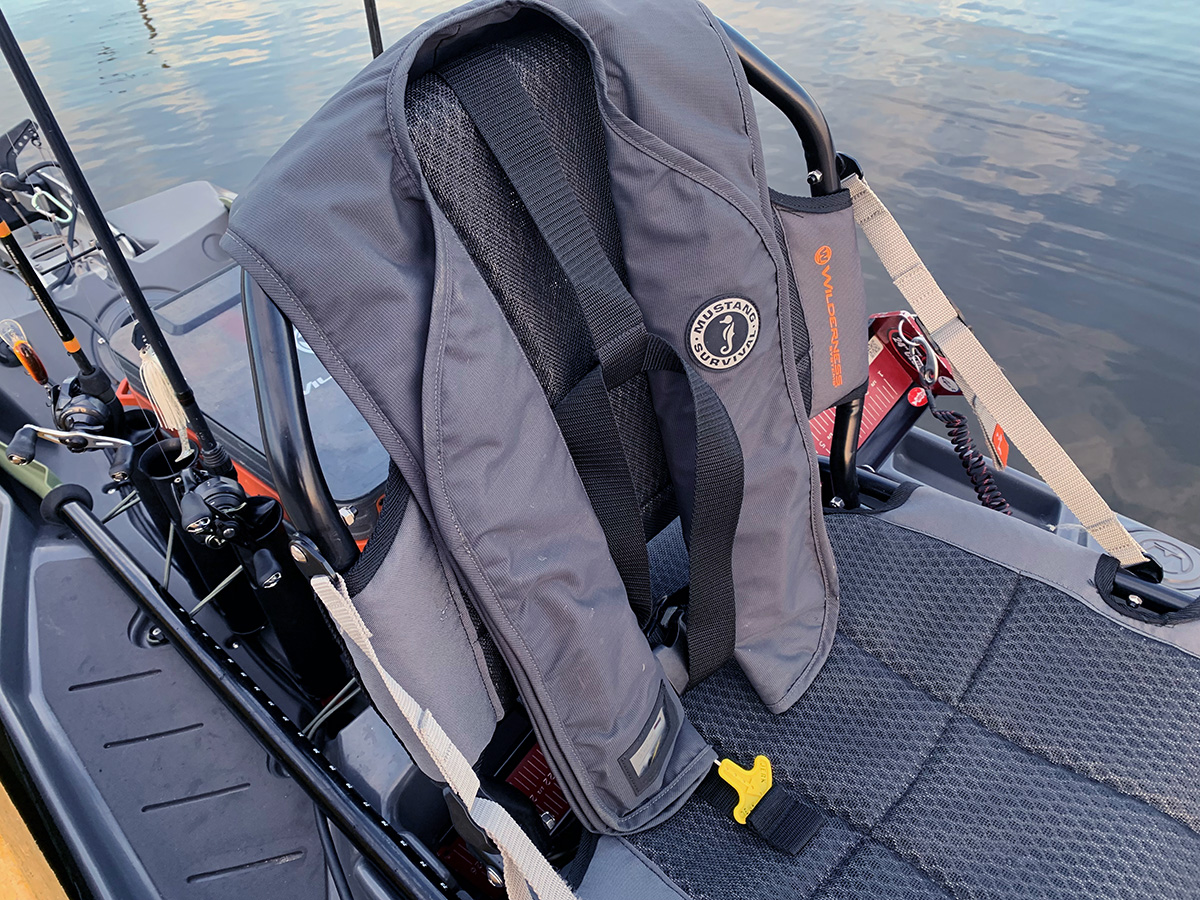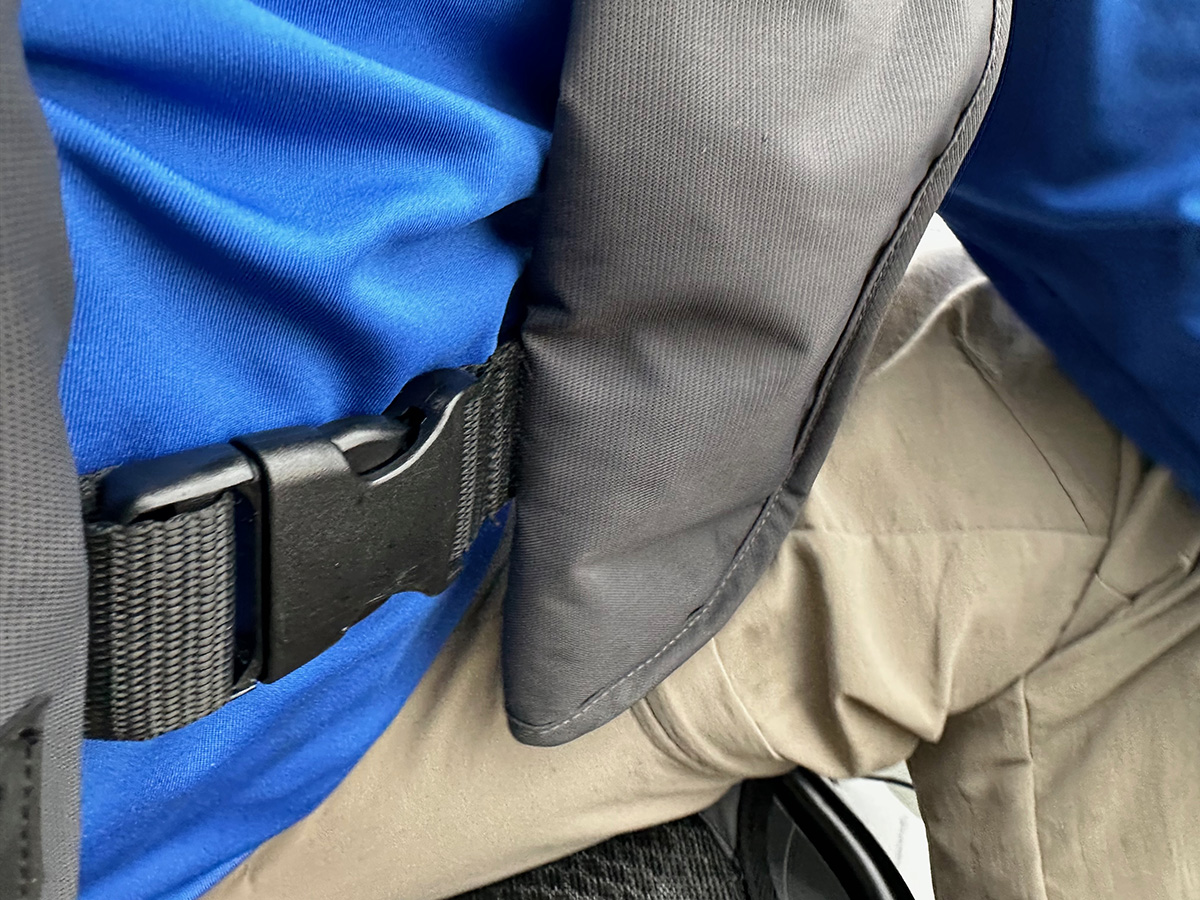Tips and Reviews
Mustang Survival M.I.T. 100 Convertible PFD Review

The one area in kayak fishing you can’t overlook is the Personal Floatation Device (PFD) choice. Fishing in competition on long days with whatever weather mother nature deems fit for the event has its challenges, choosing the right PFD can make a difference for days you need it and days you don’t. Either way we are required to wear them while competing so I wanted to review the best options on the market starting with the inflatable option. Here’s what I learned after a year of fishing with the Mustang Survival MIT 100 Convertible A/M Inflatable PFD as my go to inflatable choice.

Comfort
The main reason for going with an inflatable PFD is comfort. However that shouldn’t come at any safety cost whatsoever. As the purveyors of some good habits as well as lots of bad habits as anglers it is pretty common for us to get lackadaisical about our PFD. Sure we will buy one and wear it because we have to but most are hot, heavy, bulky and eventually stink up the backseat of your truck pretty good. Before getting my hands on quality PFDs, I can admit I was one to toss it behind the seat of the kayak on hot miserable days when fun fishing.
The M.I.T. 100’s addresses of all those things with less material and the flotation being air and not padding allowing it to be as compact and lightweight as possible. For kayak fishing there is an additional benefit of having only a couple thin straps on the back eliminating the odd contortions while sitting. The small portion around the back of the neck is hardly noticeable throughout the day. The lack of all that material means more air flow with less sweat keeping the gym bag odor with a splash of fish slime at bay.
As far as the actual act of fishing is concerned the inflatable is hard to beat for maneuverability for casting and working a bait. The elimination of the bulk provides the clearance needed to hold the rod comfortably and for the ever hopeful quality hook set on the day’s big bass.

Safety
Safety of course is paramount to the comfort. I rarely worry about getting dumped into the drink when fishing. I have a great respect for bodies of water, but that isn’t the top concern in most cases because I can swim well, and even if I fall in I’ll have the kayak to grab onto. The fear that is ever present in my mind are the boaters on the lake. The level of ignorance that exists with some boat owners causes me to feel I need a quality PFD because I may not be conscious when I need it. As I get older I am also factoring in the possibly of a health related incident. The sport lost an angler to a health incident not long ago that was younger than I am now so it does cross my mind on occasion. The automatic inflation option is perfect in that respect. I would shy away from manual only models for the reasons above. If the risks of getting dumped on a particular day are higher than normal, a standard PFD could be a better choice.
How about those days when you will be in shallow water, or other circumstances when it could actually be more detrimental to have a bulky PFD? Maybe you want to go with being tethered to your kayak as you walk the bank or fishing shallow lakes and would likely only fall in a couple feet of water all day. There wouldn’t be much need to set off the CO2 canister immediately when you can just stand up. Or possibly a wet trip in heavy rain or taking a lot of water over the bow may be a reason to not want the to prematurely deploy the vest. The M.I.T. 100 can easily convert between automatic and manual-only inflation modes by simply swapping inflator caps.

Drawbacks to an inflatable
The M.I.T. 100 PFDs are a class V with class III performance which means they need to be worn at all times to be considered a PFD. This could make the PFD not count towards the number of PFDs required by U.S. Coast Guard regulations for your vessel. See the descriptions below or check with U.S.C.G. regulations for more information.
The products information state they will right “most” people when inflated so be sure to give it a test to make sure it works for your needs if you are a well fed angler.
You will have to keep extra CO2 canisters nearby if you have a problem and it goes off. The M.I.T. 100 has a simple one fold and tuck in design with easy access to the CO2 mechanism which you will want to replace the CO2 immediately. They also have a manual inflate option for when deployed or to manually test the air bladder for leaks.
It's also recommended to replace an unused cartridge after 5 years. That is something you don’t have to concern yourself with standard PFDs. The replacement cartridges are also not “cheap” ranging from $25-$35 for a Re-Arm Kit. However funerals aren’t cheap either. Generally the amount of abuse we put our PFDs through most of us would likely replace them within 5 years anyway but it is something to keep in mind.
Another consideration is the lack of pocket storage which you find on a standard kayak PFD. With some creative kayak rigging you can find other ways to store things for quick and easy access. Check out the list of products I use and recommend below.
Using our Amazon links earn us a small commission from Amazon to support the site, but don't effect the cost to you in any way.
Where to Buy
Amazon
Mustang Survival MIT 100 Convertible A/M Inflatable PFD https://amzn.to/3NPmzpJ
Mustang Survival Re-Arm Kit D https://amzn.to/47rEppK
One Size Fits Most?
Chest size: 30”-52”
Minimum user weight: 80lbs
Understanding PFD Type Ratings
Here are PFD ratings as described on Mustang Survival’s website:
Type V*
These special use devices are to be worn for specific activities that will be described on the PFD’s label. To be effective, Type V PFDs must be used according to these specifications, and many must be worn at all times in order to qualify as a PFD. A Type V label will also list its performance as Type I, II, or III.
Type III*
Type III PFDs - or inshore buoyant vests - are specifically designed for activities where adventurers can see the shore on calm or inland waters. Inshore PFDs offer comfort without compromising on user safety, technology, or design. They stand up to the test of speed; some of our inshore solutions have some of the highest speed ratings on the market. Finally - inshore flotation that keeps up with you on your every excursion.
*Always refer to U.S. Coast Guard regulations for the proper requirements for you and your vessel.
Easy Access Kayak Storage Accessories
Wilderness Systems Mesh Storage
Attaching a mesh storage bag to the front of the seat keeps pliers, phone, emergency items right there when you need them.
https://amzn.to/3TTU1iO
Wilderness Systems Kayak Crate
The Wildy crate has a convenient top tray for easy access storage to small items you need regularly without the need to dig deep into a box.
https://amzn.to/3Sauzo7
YakAttack TracPak
Something new from YakAttack is the TracPak which allows an easy small item storage addition to wherever you have T-track on your kayak.
https://amzn.to/3NPoISj
Eric Nelson
Professional Kayak Bass Angler
Biography
I was born in Southeastern Massachusetts, where I began fishing for bass when I was in my early teenage years, graduating to competitive bass tournaments in my late 20’s. I moved to North Carolina in 2015 and found the passion for bass fishing from a kayak, and quickly became involved in both the local and national kayak bass tournament scenes. My fishing skills have allowed me to qualify for almost every major event since joining the clubs, be it at a club, state and even national level.
Being a professional in the online web development and design field for publications, I have always used my skills to help promote the clubs and the sport as a whole in my spare time. I have been a part of the club directors for Cape Cod Bass, and now for Carolina Kayak Anglers, one of the larger kayak clubs in the country. I am also a part of the national KBF tournament advisory board.
The Kayak Bass Fishing (KBF) format has allowed me to travel across the United States, fishing against the best fisherman in the country. Now with the KBF Pro format, and the merging with the FLW organization, I am looking forward to where this adventure takes me in the future.
Highlights
Total Career Earnings - $3,250
Competition Highlights
Inaugural FLW / KBF Cup Championship Qualified 2019 - Hot Springs, AK
KBF National Championship Qualified 2020 - Lake Guntersville, AL
KBF Challenge Championship 2018 - Toledo Bend, LA
2019 KBF National Championship - 57th overall out of 462 anglers - Shreveport, LA
KBF Regional Trail Championship Qualified 2019 - Lake Wheeler, AL
KBF National Trail Championship Qualified 2019 - La Crosse, WI
2nd Place 2018 KBF National Trail - High Rock Lake, NC
2nd Place 2019 - Plastic Pirates - Randleman Lake, NC
11th Place - 2019 KBF Southeastern Region Trail - Santee Cooper Lakes, SC
13th Place - 2019 KBF Southeastern Region Trail - Chickamauga Lake, TN
46th Place 2019 FLW / KBF Cup Qualifier - Nickajack Lake, TN
2nd Place - Plastic Pirates - Randleman Lake 2019
1st Place - Cape Cod Bass, 2002 - Lake Winnipesaukee, NH
1st Place - Cape Cod Bass, 2008 - Glenn Charlie Pond, MA

Comments
Be the first to comment on this article!